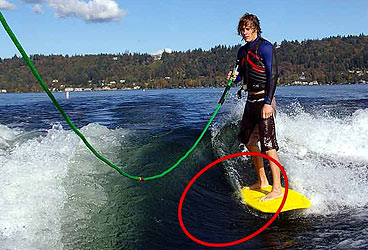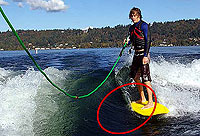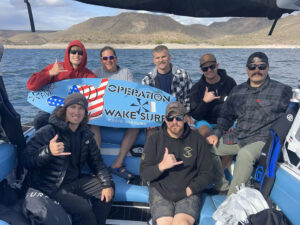Getting Started Wake Surfing
Wake surfing can be an exciting and challenging sport to add to the list of thing that make having a boat so much fun. Wake surfing is well known to be the oldest “behind the boat” sport, even predating water skiing. When done right, wake surfing will give you the feel of riding an endless wave (without the sharks or paddling).
What you’ll need:
Wake surfing board–It’s best to use a board designed specifically for wake surfing. Many people have tried to use old surfboards or large wakeboards with mixed success. For the best results (easiest to learn and more fun) get a hold a wake surfing board.
Wake surfing rope/handle–For less than 30 bucks you should be able to find a wake surf specific rope and handle. Wake surf ropes are much thicker than wake board ropes because you may need to hold on to the rope to pull yourself into the sweet spot. Wake board ropes are thin, hard to hold on to and can wrap around your hands and arms.
Inboard wake boat–This one’s important. NEVER wake surf behind an outboard or inboard/outboard boat. Outboard and inboard/outboard boats have exposed propellers and can really make a mess out of you and your board if you get too close. Only wake surf behind an inboard boat. Inboard boats have the propeller tucked up underneath the transom of the boat.
Ballast- Wake surfing usually requires additional weight on the side of the boat you intend to surf (most people surf on the port/left side). Usually adding weight towards the back of the boat will help create the wake you need to surf. Each boat is different, so experiment with weight placement and the amount of weight. Make sure not to exceed your manufactures maximum weight guidelines.
Once you have your board, rope and your boat is all setup, it’s time to wake surf.
Driving the boat- When pulling up a wake surfer, you can accelerate even slower than with wakeboarding. Gradually bring the boat up to around 10 MPH (this will vary boat to boat based on boat size, type and ballast). Ideally, the boat will create a clean (without a lot of froth or white water) wake. Drive the boat straight, not in a circle.
Getting up- Lie on your back in the water and bring your knees to your chest. Allow the board to float naturally and keep it at a 90-degree angle to you and the boat. Place your feet on the board with your heels resting on the board and your toes pointing straight up. Your feet should be right on the edge of the board closest to you. Depending on the board your back foot should be somewhere around a foot from the back of the board. Your feet should be shoulder-width apart.
When the boat accelerates and the rope tightens up, put pressure on your heels, which will flip the board up to meet your feet. Do not bring your feet down to meet the board. Once you bring the board to your feet, keep your arms straight out in front of you and keep your knees sucked up to your chest. Ride like this for a few seconds until you have come out of the water and the board begins to plane. Once you are out of the water straighten your legs, but keep your knees slightly bent.
Edge the board away from the boat and the wake so you can get your balance and adjust your feet. Depending on which side of the boat you are riding and which foot forward you use, you will want to adjust your feet so that your toes (regular riders and left side of the boat) or your heels (goofy riders on the left side of the boat) are closest to the edge of the board which is closest to the wake. This will allow you to “hold an edge” or keep the board in the side of the wave. Once you haave moved your feet, gradually edge towards the wake. Now it’s time to move into the “Sweet Spot” of the wave.
The Sweet Spot:
The “sweet spot ” is the part of the wave that generates power to keep you moving forward. If you are too far back in the wave (where it is curling over) you will find it difficult to keep up.
With most wake surf boards, to generate additional speed while riding the wave, apply weight to your front foot. This will drive the board forward towards the boat. To slow down, apply weight to your back foot. Generally, when you apply weight to your back foot to slow down, you will need to put weight on your front foot again to speed up a little. It is very important to master these fundamentals first as everything else in wake surfing is based on speed control (weight transfer).
Once you have gotten up, pull yourself into the sweet spot by grabbing the rope with your forward hand (regular riders this is your left hand, goofy riders use your right hand) and pulling towards the boat. Always remember to keep the handle in your other hand. NEVER let the handle dangle down by your legs. If you need to coil the rope, do so and hold the coil of rope with the handle in your backhand. Also, do not wrap the rope around your hands while pulling yourself into the sweet spot.
When you are first leaning to wake surf, you may find that once you have hit the sweet spot the rope will go slack. This is a good thing. You will also find that your instinct is to immediately throw the rope. Try to fight off this temptation and keep the rope with you for a while and ride with the rope slack. Do your best to keep the rope slack and ride for a while. If you find yourself too far away from the wave or too far back, use the rope to pull back into the sweet spot. While riding with the rope, it is important to only use the rope as a last resort. Use your weight transfer to speed up and slow down not the rope.
Once you feel like you can ride for a few minutes with the rope slack, it’s time to throw the rope. When you are first learning, it’s best not to throw the rope back into the boat. This tends to remove your concentration from riding and focus it towards throwing the rope. Most new riders throw the rope and watch it as it goes in the boat. They also fall right afterwards or loose the wave. To avoid this, without looking up, throw the rope to the other side of the wake (where all the white water is). The people in the boat can then safely bring the rope back into the boat and you can remain surfing.
Well, you’re wake surfing now. With a little practice, speeding up and slowing down will become second nature and you can start working on making turns and basic tricks. Good luck and have fun.










